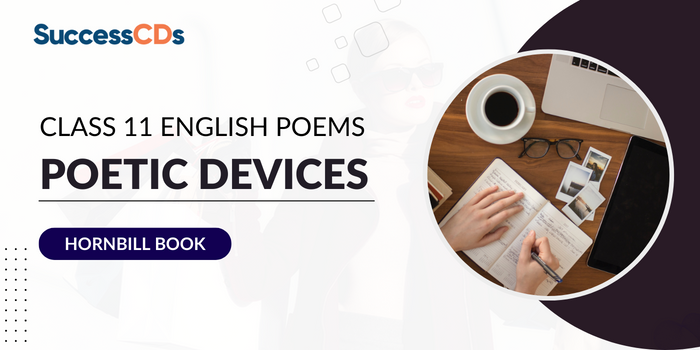
List of Poetic Devices used in Class 11 English Hornbill Book Poems
Poetic Devices in Class 11 English Poems – A “poetic device” refers to anything a poet uses to enhance the literal meaning of their poem. Poetic devices are an essential part of English poetry. It is therefore a tool that significantly enhances a poem’s substance, heightens its feel, or provides the essential rhythm. Let’s have a look at the poetic devices which have been used in class 11 English Hornbill Book Poems.
Poem 1 – A Photograph
Poetic Devices
1. Alliteration – repetition of a consonant sound at the beginning of two or more consecutive words. The instances of alliteration in the poem are as follows-
Stood still
Through their
My mother’s
Terribly transient
Silence silences
2. Epithet – a phrase expressing a quality of a person or something
Terribly transient
3. Oxymoron – a term which contradicts itself
Laboured ease
Poem 2 – The Laburnum Top
Literary Devices
1. Alliteration – repetition of a consonant sound at the beginning of two or more consecutive words. The instances of alliteration in the poem are as follows-
September sunlight
tree trembles
2. Metaphor – an indirect comparison between two things. Generally, a quality is compared.
“She enters the thickness, and a machine starts up” – the noise created by the movement of the birds is compared to the machine’s noise
“It is the engine of her family.”
“Showing her barred face identity mask”
3. Personification – the attribution of personal nature characteristics to something non-human
The whole tree trembles and thrills.
4. Simile – comparison between two things using like or as.
Sleek as a lizard
5. Transferred Epithet – the figure of speech where the adverb is transferred to another noun
her barred face identity mask

Poem 3 – The Voice of the Rain
Literary Devices
1. Hyperbole – exaggerated statements
Bottomless sea
2. Imagery – visual description of something
Soft-falling shower
3. Metaphor – an indirect comparison between the qualities of different things
I am the Poem of Earth – rain is being compared to a poem
4. Personification – the poet used a non-living thing as a living thing in the poet
I am the Poem of Earth, said the voice of the rain
Poem 4 – Childhood
Poetic Devices
1. Alliteration – The occurrence of the same letter or sound at the beginning of closely connected words
The time
My mind
Whichever way
Thoughts that
2. Antithesis – where two opposite words are used together in a sentence in a poem
Hell and Heaven
3. Individuality – In stanza 3, the poet realized that he can use his own mind and can produce his own thoughts. He discovered a sense of individuality in himself.
4. Inversion – when the subject-verb order is reversed
To use whichever way I choose
5. Rationalism – the poet rationalizes the lost childhood when he was eleven and when he found out that hell and heaven don’t exist and are not found in geography.
Was it the day I ceased to be eleven,
Was it the time I realized that Hell and Heaven,
Could not be found in Geography,
6. Refrain – a group of phrase which is repeated in the poem
When did my childhood go?
Was that the day!
7. Rhyme Scheme – the rhyme scheme used in the poem ‘Childhood’ is ABBCCD.
Poem 5 – Father to Son
Literary Devices
1. Alliteration – The occurrence of the same letter or sound at the beginning of closely connected words
The seed I spent or sown it where – ‘s’ sound
Silence surrounds us
2. Metaphor – an indirect comparison between a quality shared by two persons or things
The seed I spent or sown it where
The land is his and none of mine?
I would have
Him prodigal, returning to
His father’s house
3. Simile – a figure of speech that makes comparison and shows similarities between two things
We speak like strangers
It was too good I have been using in my school project thanks to the maker of this website
Thank you very much ❤️❤️
good effort
Very helpful at the last time.
very helpful for my last minute homework